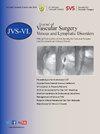深静脉血栓患者入院后立即并发肺栓塞的早期检测预测模型
IF 2.8
2区 医学
Q2 PERIPHERAL VASCULAR DISEASE
Journal of vascular surgery. Venous and lymphatic disorders
Pub Date : 2025-08-05
DOI:10.1016/j.jvsv.2025.102299
引用次数: 0
摘要
目的:建立并验证深静脉血栓形成(DVT)患者入院时高危合并肺栓塞(PE)的早期识别预测模型。材料和方法:我们回顾性收集了一组诊断为DVT的患者的数据,包括基线人口统计学、临床特征、实验室参数和基于成像的髂静脉压迫(CIV)测量,以建立预测模型。最小绝对收缩和选择算子(LASSO)回归因其同时进行变量选择和正则化的能力而广泛应用于临床决策算法,用于变量选择。然后进行多元逻辑回归,以构建nomogram。用曲线下面积(AUC)评价模型的判别能力。标定分析和决策曲线分析(DCA)。结果:将患者随机分为发展数据集(69.8%,143例PE, 130例未PE)和验证数据集(30.2%,63例PE, 55例未PE)进行模型构建和内部验证。通过LASSO回归确定女性性别、高血压、心血管疾病、骨折、年龄、d -二聚体和CIV百分比等7个预测因子,并将其纳入nomogram。该模型在训练集中的AUC为0.727 (95% CI, 0.667-0.787),在测试集中的AUC为0.707 (95% CI, 0.611-0.803)。该模型经过了很好的校准,DCA证明了在阈值概率范围为18%到80%的情况下预测PE的净收益。结论:建立了一种新的预测模型,具有较强的校准和判别能力,可用于评估深静脉血栓患者合并PE的风险。该模型有助于在获得明确的CT结果之前对PE概率进行早期估计,并支持及时的管理过程。本文章由计算机程序翻译,如有差异,请以英文原文为准。
A predictive model for early detection of concomitant pulmonary embolism in patients with deep vein thrombosis immediately upon hospital admission
Objective
To develop and validate a predictive model for the early identification of concomitant pulmonary embolism (PE) in patients with deep vein thrombosis (DVT) upon hospital admission.
Methods
We retrospectively collected data from a cohort of patients diagnosed with DVT, including baseline demographics, clinical characteristics, laboratory parameters, and imaging-based measurements of compression of the iliac vein to develop a predictive model. The least absolute shrinkage and selection operator regression, widely used in clinical decision-making algorithms for its ability to perform variable selection and regularization simultaneously, was used for variables selection. A multivariate logistic regression was then conducted to construct a predictive model. The model's discriminatory ability was assessed using the area under the curve. Calibration analysis and decision curve analysis were performed.
Results
Patients were randomly divided into a development dataset (69.8% [143 with PE and 130 without PE]) and a validation dataset (30.2% [63 with PE and 55 without PE]) for model construction and internal validation. Seven predictors, including female gender, hypertension, cardiovascular disease, fracture, age, D-dimer, and compression of the iliac vein percentage were identified by least absolute shrinkage and selection operator regression and finally incorporated into the nomogram. The model achieved an area under the curve of 0.727 (95% confidence interval, 0.667-0.787) in the training set, and 0.707 (95% confidence interval, 0.611-0.803) in the validation set. The model was well-calibrated, and decision curve analysis demonstrated a net benefit for predicting PE at threshold probabilities ranged between 18% and 80%.
Conclusions
A novel predictive model with strong calibration and discriminative power was developed for assessing concomitant PE risk in patients with DVT. This model may facilitate early estimating of PE probability before obtaining definitive CT angiography results and support timely management processes.
求助全文
通过发布文献求助,成功后即可免费获取论文全文。
去求助
来源期刊

Journal of vascular surgery. Venous and lymphatic disorders
SURGERYPERIPHERAL VASCULAR DISEASE&n-PERIPHERAL VASCULAR DISEASE
CiteScore
6.30
自引率
18.80%
发文量
328
审稿时长
71 days
期刊介绍:
Journal of Vascular Surgery: Venous and Lymphatic Disorders is one of a series of specialist journals launched by the Journal of Vascular Surgery. It aims to be the premier international Journal of medical, endovascular and surgical management of venous and lymphatic disorders. It publishes high quality clinical, research, case reports, techniques, and practice manuscripts related to all aspects of venous and lymphatic disorders, including malformations and wound care, with an emphasis on the practicing clinician. The journal seeks to provide novel and timely information to vascular surgeons, interventionalists, phlebologists, wound care specialists, and allied health professionals who treat patients presenting with vascular and lymphatic disorders. As the official publication of The Society for Vascular Surgery and the American Venous Forum, the Journal will publish, after peer review, selected papers presented at the annual meeting of these organizations and affiliated vascular societies, as well as original articles from members and non-members.
 求助内容:
求助内容: 应助结果提醒方式:
应助结果提醒方式:


